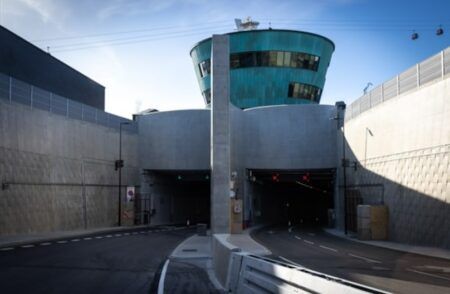The Louisiana Department of Transportation and Development (DOTD) has activated ramp meters on US 90B/Pontchartrain Expressway, one of the key routes in New Orleans around the Central Business District (CBD), in a bid to improve traffic flow and driver safety.
The DOTD’s new ramp meters are an innovative and effective traffic management strategy designed to reduce congestion, provide safer merging and improve travel time reliability. Under two projects, a total of seven ramp meters have been installed, three in the river-bound direction and four lake-bound.
The US$3.6m project to lengthen the Claiborne on-ramp onto US 90 B, restripe US 90 B from two lanes to three lanes, and install one ramp meter was started in February 2015 and completed in January 2016. Across US 90 B, six additional meters were installed as part of the US$1.8m New Orleans Hospitality Zone project that began in April 2015 and is now nearing completion. Each project was designed to relieve congestion and improve safety and travel times. The meters will be activated Monday through Friday, 6:30am 9am and 3pm 7pm. They will also be activated for special events or any incident that increases traffic volume in the corridor.
In Louisiana, the first ramp meters were fully activated in Baton Rouge in both directions of I-12 in summer 2012. They have proven to reduce instances of crashes and allow for more predictable travel times, thus making for a more efficient and safer daily commute. Data shows that ramp meters can reduce crashes by as much as 30%, given certain variables.
Ramp meters are stop-and-go traffic signals that control the frequency with which vehicles enter the flow of traffic on the freeway. They are located on the Pontchartrain Expressway on-ramps and look similar to a traffic signal. A red signal directs the motorist to stop for a few seconds until the green light is activated, signaling the motorist to proceed and safely merge onto the expressway. The green light accommodates one car per lane. On entrance ramps with two lanes, the green signal will alternate between the two lanes. When the ramp meter signal is turned off, motorists merge as usual. DOTD will monitor the meters from the New Orleans Regional Transportation Management Center and adjustments will be made as necessary.
“In order for us to be competitive, both regionally and nationally, we must have an innovative and competitive transportation infrastructure system that takes advantage of technology,” explained Shawn D Wilson, Louisiana DOTD Secretary. “Utilizing the ramp meters will serve to decrease congestion, improve travel times and enhance safety along the multimodal US 90 B corridor. That translates to people getting to and from work, and goods and services being delivered in a more efficient and timely manner; and doing so more safely during peak travel periods.”




